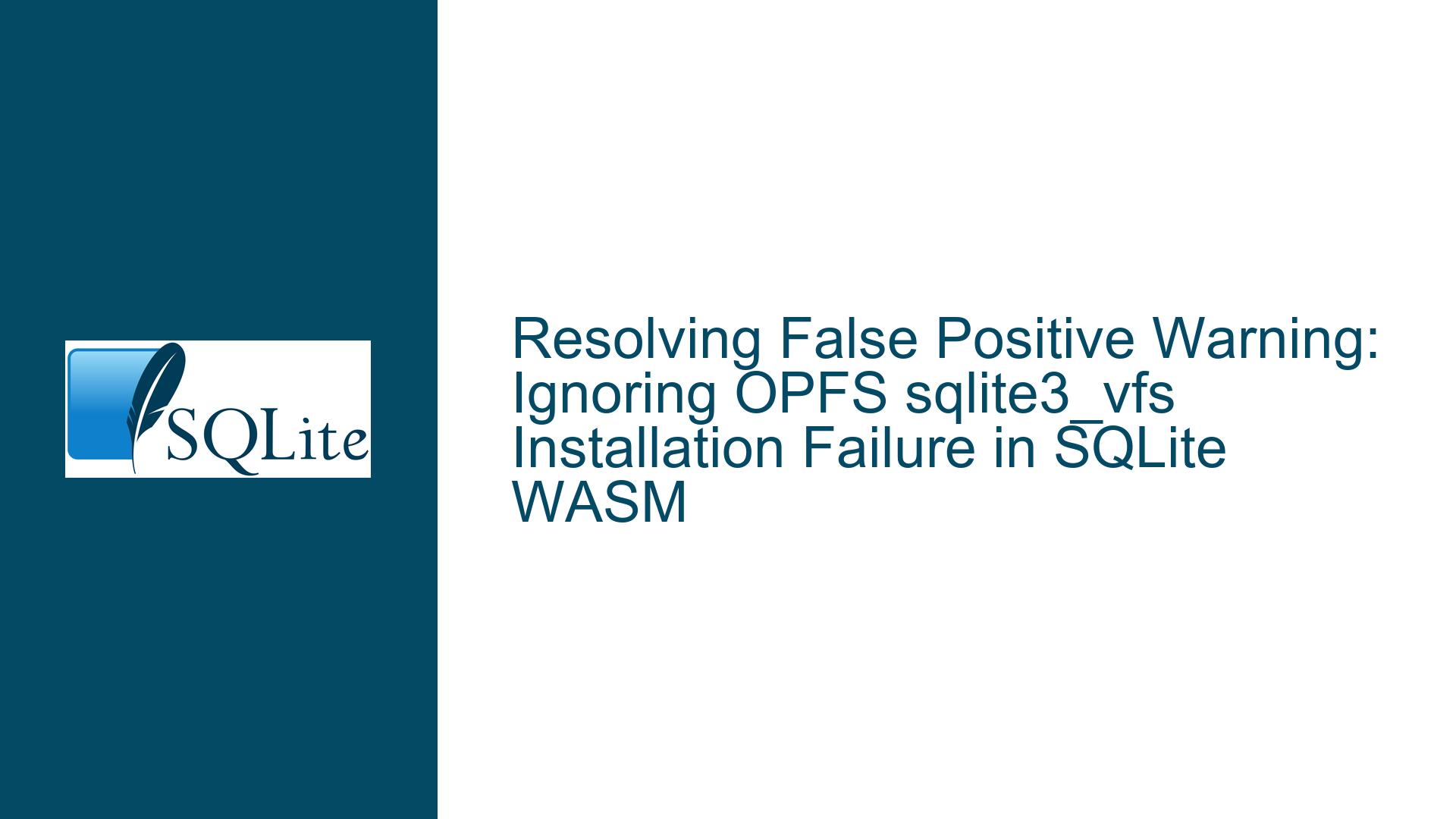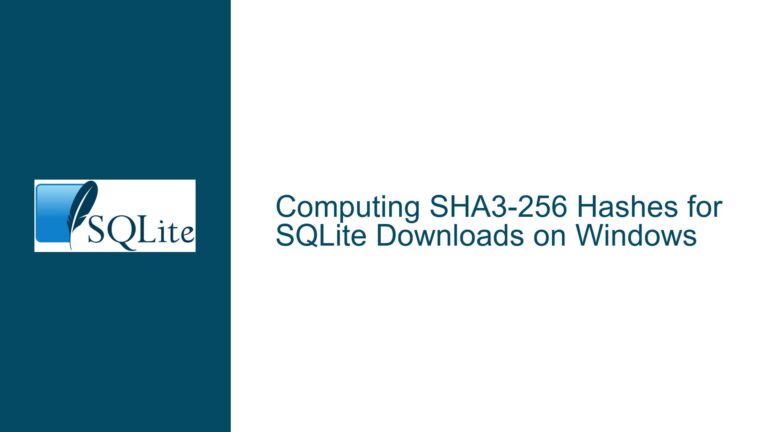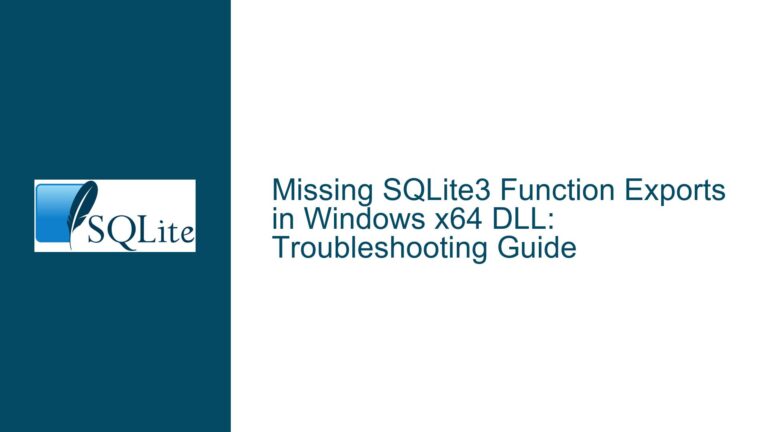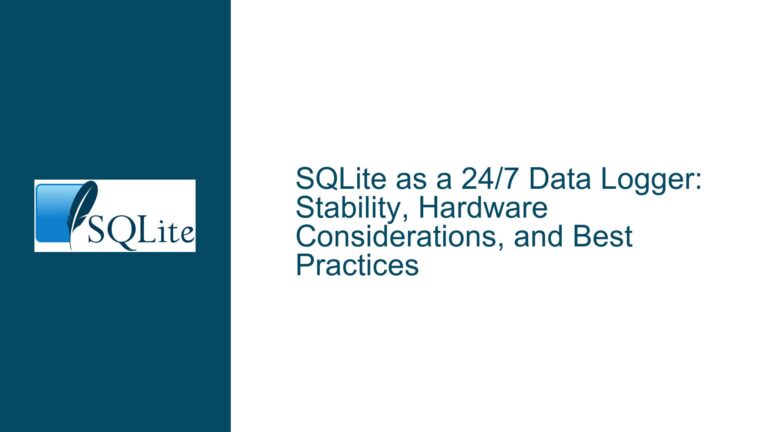Resolving False Positive Warning: Ignoring OPFS sqlite3_vfs Installation Failure in SQLite WASM
Understanding the OPFS VFS Warning in SQLite WASM with opfs-sahpool
Issue Overview
A persistent warning message occurs in SQLite WASM implementations when attempting to install the OPFS (Origin-Private File System) sqlite3_vfs (Virtual File System):
Ignoring inability to install OPFS sqlite3_vfs
This warning appears even after:
- Switching from the default OPFS VFS to opfs-sahpool (a specialized VFS implementation for concurrent access).
- Removing COOP/COEP HTTP headers (Cross-Origin Opener Policy / Cross-Origin Embedder Policy).
- Confirming that database operations otherwise function correctly.
The warning is misleading because it suggests a failure to install the OPFS VFS, but the actual issue stems from the coexistence of multiple OPFS VFS implementations in the environment. Specifically, opfs-sahpool and the default OPFS VFS both attempt to register themselves, but only one can operate successfully without COOP/COEP headers. The warning is triggered by the default OPFS VFS failing to install, not the opfs-sahpool VFS. This creates a false positive that obscures the true operational state of the database.
A secondary concern involves multi-tab concurrency management when using opfs-sahpool. Developers implementing tab synchronization via Web Locks API and BroadcastChannel must account for edge cases such as tabs closing during active transactions. Failure to handle these scenarios can lead to transaction state corruption or data inconsistency.
Root Causes of the False Positive Warning and Concurrency Challenges
Possible Causes
Coexistence of Multiple OPFS VFS Implementations
SQLite WASM includes multiple VFS implementations for OPFS. The opfs-sahpool VFS is designed for concurrent access but shares the same underlying OPFS infrastructure as the default VFS. When both attempt to initialize, the default VFS may fail due to missing COOP/COEP headers, triggering the warning even though opfs-sahpool operates correctly.Incomplete Configuration of COOP/COEP Headers
The default OPFS VFS requires COOP/COEP headers to enforce security policies for cross-origin isolation. Removing these headers disables the default VFS but leaves opfs-sahpool functional. However, the warning persists because the initialization logic checks for the default VFS’s installation status, unaware of opfs-sahpool’s independence.VFS Initialization Order and Fallback Logic
SQLite WASM attempts to register OPFS VFSes in a specific order. If the default VFS fails to install (due to missing headers), the runtime falls back to other VFSes but still logs the failure. This creates noise in environments where opfs-sahpool is explicitly chosen.Unhandled Transaction States in Multi-Tab Environments
When using Web Locks and BroadcastChannel to coordinate database access across tabs, abrupt tab closures during transactions can leave locks held or transactions uncommitted. Without recovery mechanisms, subsequent tabs may encounter locked databases or partial writes.
Mitigating the Warning and Ensuring Robust Concurrency
Troubleshooting Steps, Solutions & Fixes
1. Suppressing the False Positive Warning
Step 1: Explicitly Select the opfs-sahpool VFS
Ensure your initialization code explicitly configures opfs-sahpool as the preferred VFS. Example:
const sqlite3 = await sqlite3InitModule({
vfs: 'opfs-sahpool' // Force use of sahpool VFS
});
This bypasses the default VFS registration, preventing the warning.
Step 2: Validate HTTP Headers and Cross-Origin Isolation
Even though opfs-sahpool does not require COOP/COEP, verify that headers are either fully removed or consistently configured. Mixed configurations (e.g., headers set in some responses but not others) can cause unpredictable behavior.
Step 3: Patch the VFS Initialization Logic
Modify the SQLite WASM initialization script to suppress warnings when opfs-sahpool is active. Locate the VFS registration block and add a conditional check:
if (!vfsName.includes('sahpool')) {
console.warn('Ignoring inability to install OPFS sqlite3_vfs:', err);
}
2. Implementing Multi-Tab Concurrency with Web Locks and BroadcastChannel
Step 1: Integrate Web Locks for Transaction Serialization
Use the Web Locks API to coordinate write access across tabs. Acquire an exclusive lock before starting a transaction:
await navigator.locks.request('database-write-lock', {mode: 'exclusive'}, async () => {
await db.exec('BEGIN;');
// Execute queries
await db.exec('COMMIT;');
});
Step 2: Leverage BroadcastChannel for State Synchronization
Notify other tabs of database changes using BroadcastChannel:
const channel = new BroadcastChannel('database-events');
channel.postMessage({type: 'refresh'});
Listen for messages in other tabs to reload data or invalidate caches.
Step 3: Handle Tab Closure During Transactions
Use the Page Visibility API and beforeunload event to detect tab closures. If a transaction is active, attempt to commit or roll back:
window.addEventListener('beforeunload', async (e) => {
if (transactionInProgress) {
e.preventDefault();
await db.exec('COMMIT;'); // Or ROLLBACK;
}
});
Caution: This approach is not foolproof, as the browser may terminate the tab before the cleanup completes. Design transactions to be idempotent where possible.
3. Addressing Non-Idempotent Writes and Transaction Recovery
Step 1: Journaling and Transaction Logs
Maintain a journal of pending transactions outside the database (e.g., in IndexedDB). If a tab crashes mid-transaction, recover by replaying the journal:
// Pseudocode
try {
await beginTransaction();
await writeToJournal({action: 'update', table: 'users', data: newData});
await executeDbUpdate(newData);
await commitTransaction();
await clearJournal();
} catch (e) {
const pending = await readJournal();
if (pending) {
await reapplyPendingActions();
}
}
Step 2: Use Atomic Operations and Idempotent Queries
Structure writes to be retry-safe. For example, use INSERT OR REPLACE instead of separate UPDATE/INSERT statements.
Step 3: Leverage SQLite’s Write-Ahead Logging (WAL)
Enable WAL mode for finer-grained concurrency control:
PRAGMA journal_mode=WAL;
WAL allows reads to proceed concurrently with writes, reducing lock contention.
4. Browser-Specific Considerations and Testing
Step 1: Verify Cross-Browser Support for Web Locks
As of 2024, Web Locks are supported in Chromium-based browsers and Firefox but have limitations in Safari. Test fallback strategies (e.g., polling) for unsupported browsers.
Step 2: Monitor Adoption of New Locking Primitives
Chrome’s proposed locking APIs for OPFS (e.g., AccessHandles) may offer improved concurrency. Track their standardization progress and plan for incremental adoption.
Step 3: Audit Browser Console and Network Traffic
Use browser dev tools to confirm:
- No residual COOP/COEP headers are present.
- The correct VFS (
opfs-sahpool) is active:
console.log(sqlite3_vfs_list()); // Should list 'opfs-sahpool'
By addressing the VFS initialization sequence, suppressing redundant warnings, and implementing robust concurrency controls, developers can eliminate false positives and ensure reliable multi-tab operation in SQLite WASM applications.






